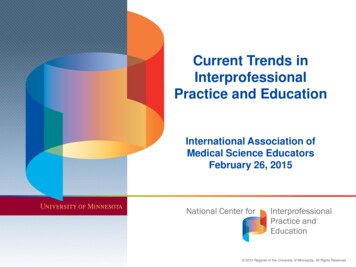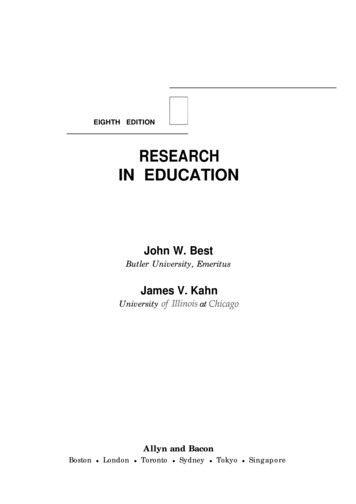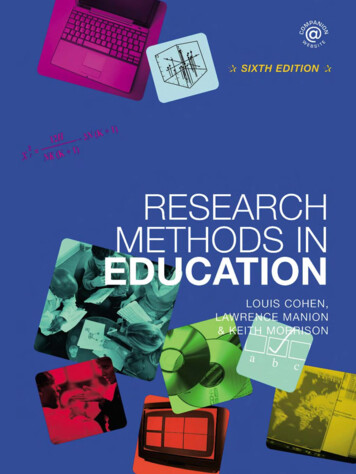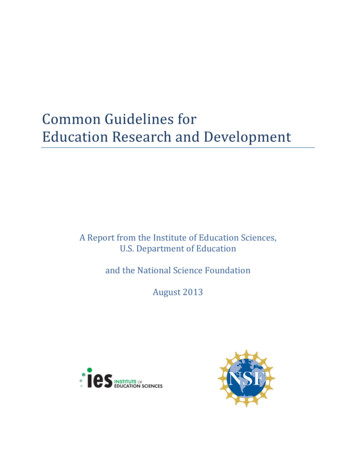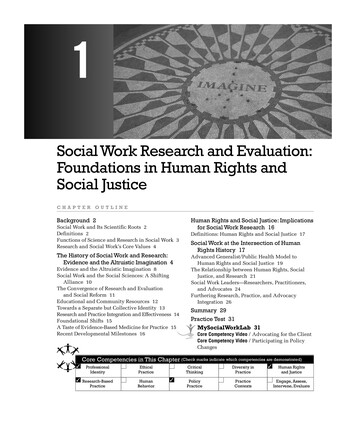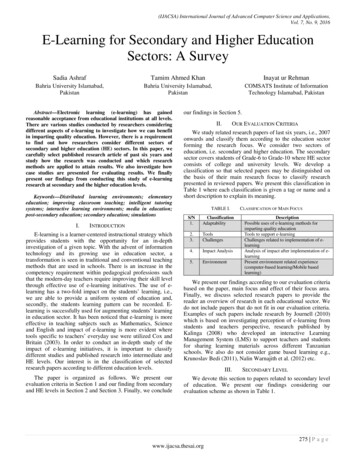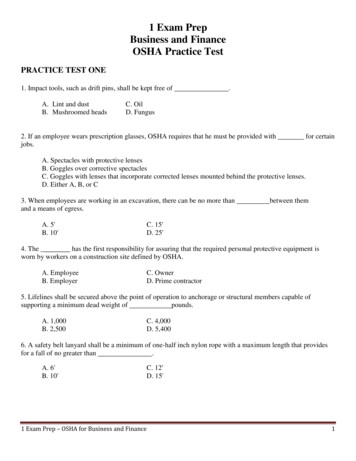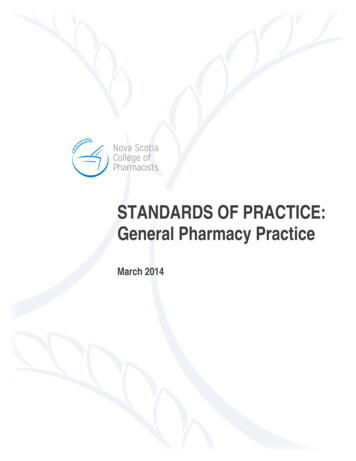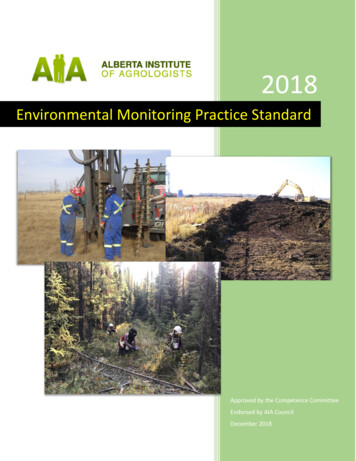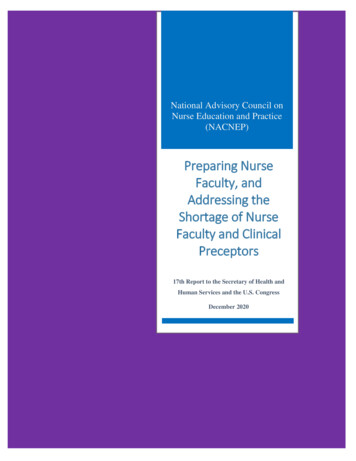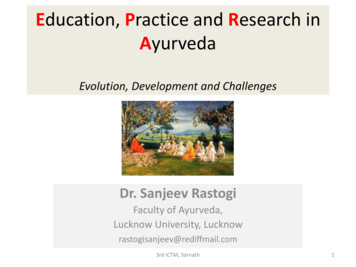
Transcription
Education, Practice and Research inAyurvedaEvolution, Development and ChallengesDr. Sanjeev RastogiFaculty of Ayurveda,Lucknow University, Lucknowrastogisanjeev@rediffmail.com3rd ICTM, Sarnath1
Health Care MatrixEducationPracticeResearchNet Health Care Delivery3rd ICTM, Sarnath2
Reciprocal Evolution of Health CareMatrixEducationPracticeResearch3rd ICTM, Sarnath3
Historical Evolution of Health Science Inclusive– Versatility of roles related to health care– Single person playing multiple roles as Educator/Physician/ Researcher/Dispensor/ Social worker/– Early Ayurveda and Modern science was developed this way Exclusive– Focused approach leading to specialized roles within thespecified disciplines Inclusive– Due to lost interconnectedness between various disciplines– Due to lack of translational appeal– Re emergence of need of cross disciplinary knowledge hencepromoting the disciplines like Physician Scientist/ Vaidya Scientist3rd ICTM, Sarnath4
Ayurveda : An Eternal �: शाश्वतो निनदि श्यते, अिानदत्वात, स्वभार्व संनसद्ध लक्षणत्वात,भार्व स्वभार्व नित्यत्वाच्च ( च.सू.३०/२५)1. अनादित्वात :1.It has no precise point of origin.2.Largely is a science based on health and disease observations madethrough millenniaBrahma has only recalled the knowledge and did not produce it1.सर्विदा सर्वि भार्वािाम सामान्यम र्वृद्धद्ध कारणम। (Like increases the like and2. स्वभार्व संनसद्ध लक्षणत्वात: Its fundamentals are selfexplanatory through the observations and applicationsunlike decreases the like)3. भार्व स्वभार्व दनत्यत्वाच्च: Its meanings and nature areuniversally true beyond the time and space1.2.What was fundamentally true thousand years back is largely truetoday alsoWhat is fundamentally true at one part of the world is true in otherparts of the world also3rd ICTM, Sarnath5
Mythological Descent of AyurvedaAyurveda Knowledge in DivinePossessionAyurvedaKnowledge inSagic PossessionAyurvedaKnowledge inHuman Possession3rd ICTM, Sarnath6
Learning Transitions in Ayurveda Intuitive Learning– Continuous and curious observation of nature’s healingand disease causing properties– Knowledge transfer to next generations through oraltradition Systematic Learning– Required due to knowledge accumulation over the generations Demand and respect generated for those who possess thisknowledge– Ayurveda established as a distinct discipline of study andcareer– Systematic learning begun through time bound supervisedteaching and training programs3rd ICTM, Sarnath7
Gurukula: Earliest Mode of SystematicLearningEarly and Later VedicPeriod 1500-500 BC3rd ICTM, Sarnath8
Peculiarities of Gurukula Learning A fully residential teaching and training program– Conducted away from home at Ashrama– Focused learning initiated at an early age– Course completion on the discretion of Guru Practice combined with Education– Learning about the raw materials and their processing– Learning about the patient examination– Learning about the clinical and therapeutic interventions Interactive method of learning– Most teachings initiated as replying to the questions of students Learning the fundamentals by adopting them in life– Life at ashrama driven by ayurvedic principles Applying individual skills to solve the clinical riddles– A large praise for becoming yuktigya is available every where in Ayurveda Uniform teaching irrespective of class/ social standard of the disciple– Famous krishna and Sudama story who were students of the same guru3rd ICTM, Sarnath9
Symposiums and Assembliesर्वैद्य समूहो नि:संशयकराणामReaching at consensus on complex issues by arriving ongeneral agreementतनिदसम्भाषा �ामAssembly of peers helps expanding the wisdomआचायि : शास्त्रानर्गम हे तूिाम।An expert is primary requisite to initiate learning in asubject3rd ICTM, Sarnath10
Professional Etiquettes– Recognition and respect to all having specialized skills andknowledge Knowledge about plants and their healing properties may beobtained from shepherds and tribal people ओषर्ी िामरूपाभ्याम जािते ह्यजपा र्विे। अनर्वपाश्चैर्व गोपाश्च ये �:॥ च.सू.१/१२१– Respecting the opinion of other’s despite of differences Various symposiums and assemblies organized in Ayurveda– Seeking the opinion of others in the area of other’sexpertise Medical School versus Surgical School3rd ICTM, Sarnath11
Assuring the Quality Driven EducationRight education For Right students by Right teachers Right education– Choose the appropriate subject of study on the basis of Quality and scope of the subject Ultimate objectives of the study Right studentsCrossevaluationtechniquefor qualitydriveneducation– Choice of subject as per the ability of student– Student selection by teachers on the basis of predefined qualityparameters Right Teacher Qualities of a teacher / school the student should look into General Code of Conduct related to Quality Education– Code of Conduct for teachers upon the acceptance of a student fortraining3rd ICTM, Sarnath– Code of conduct for student and for trainee physicians12
University Based Education in Ancientand Medieval India Takshashila UniversityDestroyed in 499 AD– Worlds oldest university– Over 10000 students at a time , 64 disciplines of study– Graduates like Chanakya , Panini, Vishnu Sharma, Jivaka, Charaka Nalanda UniversityBuild in 5th Cent AD– Large library– Students from many countries like Korea, Japan, China, Indonesia,Tibet, Persia and Turkey. Vikramashila University8th Cent AD – 12th Cent AD– 100 teachers 1000 students Valabhi UniversityPushpagiri UniversityOdantapuri UniversitySomapura University6th Cent in Gujrat3rd Cent AD in Odisa8th Cent in Bihar8th Cent AD in Bengal3rd ICTM, Sarnath13
Current Ayurveda Education in India Characteristics– Uniform teaching and training program through out the country– Regulated by mandatory norms enacted through various Billsand Acts– Education disbursement through identified institutions fulfillingthe Minimum Standard Requirements for graduate and postgraduate programs– Time bound and syllabus based teaching and training– Compulsory Internship program to give practical learning Regulating authorities– Syllabus , infrastructural and teaching standards by CCIM– Examinations by universities providing affiliation to the colleges– Human resource recruitment by state / central authorities (PSC, UPSC, Ministries )3rd ICTM, Sarnath14
Infrastructure of Ayurvedic Educationin India ( as on 1.4.2016) UG colleges279– BAMS Seats PG Colleges15,117112– MD/MS Seats Hospitals3,0292,836– Beds 42,755Dispensaries1,527Registered practitioners4,19,217Pharmacy7,439Paramedical Colleges?– Paramedic seats?3rd ICTM, Sarnath15
Current Programs Offered in Ayurveda Conventional ProgramsOperating throughuniversities/ Organizations) Non Conventional Programs(Operating through informalsources ) Online CoursesDistant learning ProgramsShort term training programsHands on training workshopsContact Learning Program Knowledge enhancing programs– Introduction to Ayurveda– Diet– Healthy livingProfessional skill improvisation programs– Pancha karma– KsharasutraVocational programs aiming to provide jobopportunities– Pancha karma technician– Kshara sutra technicianBasic Courses– Specialty Courses– Certificate Courses- CRAVMembership courses- MRAVDiplomaInterdisciplinary Courses–––– MD, MS, PhDIntermediary Courses––– BAMSHospital Management/ HospitalAdministrationHealth ManagementPublic HealthYogaParamedical Courses–Nursing / Pharmacist / Panchakarmatechnician/ Masseur 3rd ICTM, Sarnath16
Current Education Standards inAyurveda: All is Not Well? Quantitative Deficits– Disproportionate distribution of teaching institutions Over 50% colleges and seats are located in 4 states: Karnataka, MP, Maharashtra,and UP ( KaMMaU states for Ayurveda )– Poor Physician : Population Ratio 31/ one lakh population ( In Allopathy it is 60/ one lakh) Nil representation in many areas including North Eastern States Qualitative Deficits– Non Institutionally Qualified (NIQ) 20% of total registered physicians– Huge Institution based qualitative differences– Quality dilution by rapidly rising number of private institutions– No increase of Government institution numbers in past many years– Government institution are no better in quality– No operational ‘standard ayurveda care’ at teaching institutions for most clinicalconditions– Production of graduates with qualifications and without skills– Lack of confidence brings a desire of being supported with modern medicine3rd ICTM, Sarnath17
Growth of Ayurveda Education in PastTwo Decades( 1993-2016) Growing below the population growth rate?––––HospitalsDispensariesRegistered PractitionersPharmacy1.3%0.6%0.7%0.2% Growing above the population growth rate ?–––––UG CollegesUG seatsPG CollegesPG seatsBeds4.2%5.6%5.9%9.3%2.4%1. Mostly in private sector3rd ICTM, Sarnath2. Hospital beds are often non functionalPopulationGrowth Rate inIndia in 2016was reportedto be 1.3%18
Specialty Education in Ayurveda MD and MS in 22 Subjects– About 3500 specialists are produced in a year– Orientation of specialty and super specialty in Ayurveda– Producing experts and specialist as competent and efficientteachers/ clinicians (Physicians, Surgeons,Obstetricians)/Researchers/ pharmacy experts and Scholars PG Diploma in 16 clinical subjects– Aims and Objects- To produce efficient Ayurveda specialist in3rd ICTM, Sarnathclinical specialties19
Clinical Ayurveda Specialists: Where areThey? Ayurveda clinical specialists are not traceable at– Private practice– Ayurveda district hospitals and dispensaries– Ayurveda facilities co located at allopathic hospitals/ medical colleges Where the Ayurveda Post Graduates go?– Faculty members in colleges Rapid rise in UG and PG Colleges Possibility of getting engaged in allied disciplines– Kaya Chikitsa – Agada tantra/ Nidana/swastha vrutta/ panchakarma– ShalyaShalakya/ Prasuti Stree Roga– Medical officers No utilization of particular branch of specialization– Research officers at CCRAS No utilization of particular branch of specializationPurpose of producing experts remains largely defeated in current3rd ICTM, Sarnath20job scenarioin Ayurveda
Faculty Members at Colleges: Do WeReally Have Clinical Specialties? Every day number of enquiries are made at college hospitalsregarding specialist for various conditions like– Diabetes, Skin diseases, Arthritis , Gastroenterology, Psychiatry, SexualDisorders , Cancer , Renal diseases Unfortunately there are no genuine replies to these enquiries For most of such clinical conditions, there are no real expertsavailable at ayurveda teaching hospitals There are more generalists than specialists and therefore everyonetreats every condition3rd ICTM, Sarnath21
Ayurvedic Clinical Practice Underutilized Skills of specialists at regular jobs– Trained clinical specialists often don’t enter into specialty practice andprefer a routine job underutilizing their skills Imposter Specialists– Private practice being devoid of real specialists becomes a breedingground of self proclaimed specialists– Various branches of practice of medicine have such self proclaimedspecialists DiabetesSkin diseases/ PsoriasisKidney diseases/ Renal FailureArthritisCancerSexual diseasesNeurological disorders / epilepsyGastrointestinal disordersWeight loss and gain therapyCosmatology3rd ICTM, Sarnath22
Questioned Prescription Quality3rd ICTM, Sarnath1. Poor prescriptionquality atteachinginstitutions2. No standardformat ofprescriptionwriting3. Missingimportant clinicalinformation formayurvedicperspectives4. Not able to beconsidered as aclinical recordevidence 23
Rationality of Prescriptions1. Irrationalprescriptions2. Overuse ofproprietarydrugs over theclassical drugs3. Over use ofHerbometalicpreparationsover theherbal alonedrugs4. Over use ofpancha karmaprocedureswithout duerationality3rd ICTM, Sarnath24
Research in Ayurveda: EvolutionaryPerspectives Observational Research–– Observing the disease causing potential of various etiological factorsObserving the healing potential of various natural resourcesExperimental Research––Surgical explorations on animals and humansExperimentations on different drug routes Operational Research–– To improve health care delivery नचनकत्सा चतुष्पाद/ षोडश कला नचनकत्साTo improve educationTo improve ethics in practiceResearch in pharmaceutics–– Development of treatment protocolsDevelopment of surgical and panchkarma instruments for precise functionsQualitative Research––– oral/ rectal/ nasal/ topicalDevelopment of various formulationsDevelopment of various drug delivery formsClinical Research–––Clinical Pattern recognition to make a diagnosisDetermining the drug doses in various conditions and populationsTreatment protocol determination Rasayana durationPanchakarma procedures3rd ICTM, SarnathA highlyadvancedresearchorientationandmethodologyis observablein AncientAyurveda 25
Classical Methods of AcquiringKnowledge in Ayurveda प्रत्यक्षDirect Observation अिुमािInference based uponprevious observations आप्तोपदे शUniversal Facts/ Principles युद्धिExperimentation3rd ICTM, Sarnath26
R evolutionary Aspects of AyurvedaResearch ContinuousReal lifeHolisticTranslatableNeed basedLocal resource orientedThis approach of Ayurvedic research of thentimes was able to produce all time great healthcare knowledge compiled in र्वृहतत्रयी and लघुत्रयी3rd ICTM, Sarnath27
Ayurvedic ResearchThenMindthe GapAnd NowMind theDirectionsAlso3rd ICTM, Sarnath28
Contemporary Research in Ayurveda Poor in Quality– Small sample number, inappropriate randomization, absence ofcontrol, poor data analysis Poor in Quantity– Less number of researchers– Less number of quality publications Inappropriate Focus– Pilot clinical trial on old formulations (र्ात्री लौह)– Experimental researches on extracts– Minimal researches involving observational studies/translational studies/ feasibility studies/ cost effectivenessstudies/ qualitative studies / fundamental studies/ validationstudies– Minimal focus on what is needed to understand thefundamentals3rd ICTM, Sarnath29
Hierarchy of EvidencesCommonAyurvedicResearches donot find acomfortable placein existinghierarchy ofevidences3rd ICTM, Sarnath30
Evidences in Ayurveda: Soaring Gaps ? Dose and response relationship ? Special population dosing?– Pediatric ?– Geriatric ?– Pregnancy and lactation? Doses in the presence of a concomitant illness Interactions ?– Herb-herb interaction– Herb Food interaction– Herb Drug Interaction ?Primary and secondary end points of the interventionsDeliverables in reference to the time?Cost effective analysis ?Essential therapy and supportive therapy?Primary therapy and maintenance therapy?And the list continues further .3rd ICTM, Sarnath31
What if the Rigorous Research BasedEvidences are absent ? Difficult to answer thequestions related to thecourse of the therapy andexpected out comes. Patient’s choice of healthcare system will remainbelief based and notevidence based. Benefits or No benefits isjust the matter of chance3rd ICTM, Sarnath32
Immediate Challenges in Ayurveda? Lack of Dependability– Uncertainty of the results Inability to address the immediate needs of thepeople– Millions of people in world are ready to give upmodern medicine if ayurveda can give them a promisefor better life without using modern medicine The Challenges are– To make Ayurveda really dependable– To identify the health care needs of people and toredesign Ayurveda to suit the needs3rd ICTM, Sarnath33
What People Look From a ServiceProvider : Putting RATER to AyurvedaDoes itdeliver as itpromisesDoes itinspire theconfidenceDoes it presentsprofessionally withall what is neededto diagnose and tocureHow competent theprofessionals are inlistening and resolving theproblems of patientsHow Quick theresponses may3rd ICTM, Sarnathbe delivered34
Steps for Generating Dependability Percolating principle of knowledge transferResearchEducationPractice3rd ICTM, Sarnath35
Future Trends: Global and Indian Increasing demand of Ayurveda in public Increasing awareness about principles of healthy livingincluding food and routine Increasing willingness of getting away from modernmedicine and considering it as a last option Increasing tendency to prefer conservativemanagement than surgical management Increasing inclination of modern scientists tounderstand ayurveda better Increasing investment on research in Ayurveda both inPrivate and Govt. sect.3rd ICTM, Sarnath36
The World Seem to Have SetEmbracing AyurvedaThis is time for Ayurveda to show up itsreadiness for getting embraced3rd ICTM, Sarnath37
3rd ICTM, Sarnath38
Diabetes Skin diseases/ Psoriasis Kidney diseases/ Renal Failure Arthritis Cancer Sexual diseases Neurological disorders / epilepsy Gastrointestinal disorders Weight loss and gain t
